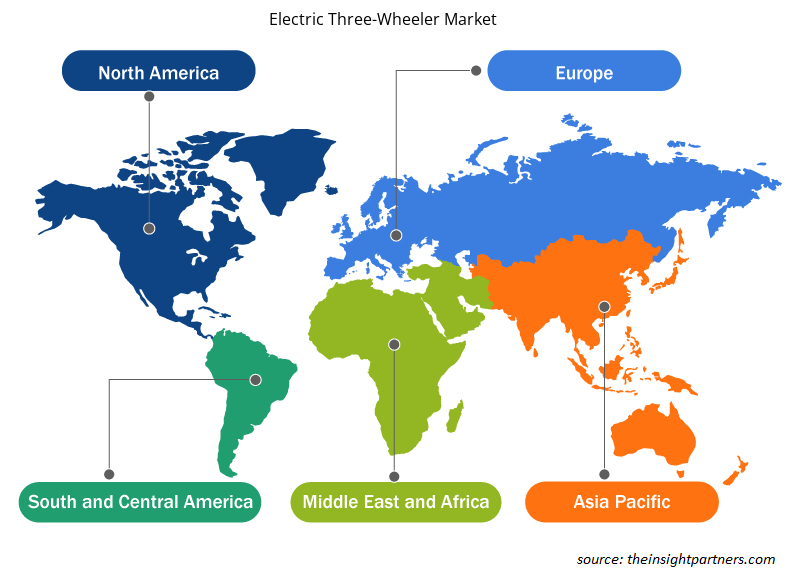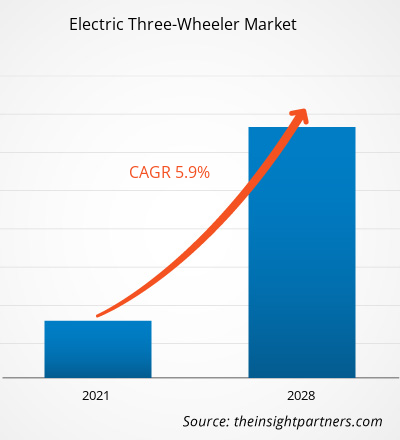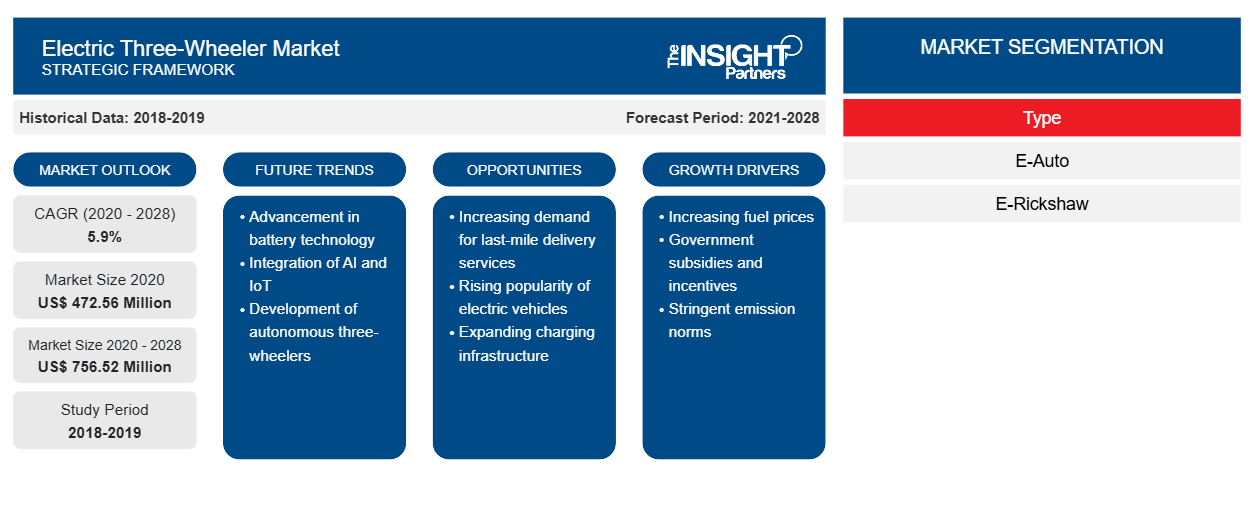電動三輪車市場は2020年に4億7,256万米ドルと評価され、2028年までに7億5,652万米ドルに達すると予測されており、 2021年から2028年にかけて5.9%のCAGRで成長すると予想されています。
電動三輪車は、乗客を目的地まで運ぶためだけでなく、貨物の輸送にも広く使用されています。これらの三輪車は、充電式バッテリーで駆動する電動モーターで動きます。バッテリーは、電気充電ステーションまたはその他の充電ポイントで充電できます。世界中の多くの低所得国および中所得国では、もともと内燃機関 ( IC ) で駆動していた三輪車の使用率が高くなっています。しかし、これらの内燃機関三輪車のほとんどは非効率で古くなっています。このため、メーカーは電動三輪車の研究開発への支出を増やしています。さらに、電動三輪車は、特に短時間で少数の乗客と小型の貨物を輸送するために、都市部や郊外で非常に人気があります。電動三輪車市場の成長を牽引する主な要因には、汚染防止に関する政府の厳格な規範と規制、ディーゼル車とガソリンからの排出物の有害な影響に関する意識の高まり、および電気自動車の受け入れの増加があります。ガソリンとディーゼルは枯渇性資源であるため、人々はすでに他の可能な代替品について考え始めています。電気三輪車は、ガソリンやディーゼルの三輪車に取って代わり始めています。電気三輪車の平均的なメンテナンスおよび運用コストは、従来の三輪車よりも大幅に低くなっています。しかし、重いバッテリーパックと走行距離の短さは、電気三輪車メーカーが直面している懸念事項の一部です。電気三輪車はバッテリーをフル充電すると約125〜130 km走行しますが、従来の車両は燃料タンクを満タンにすると約200〜220 km走行します。
2020年の電動三輪車市場はアジア太平洋地域が優勢でした。インドは、この地域の電動三輪車市場の最大の株主の1つです。インドの低排出ガス車産業は、政府による有利な取り組みや、マヒンドラ&マヒンドラ、アトゥルオート、ピアッジオ、ロヒアオートなどのメーカーの強力な存在を背景に、急速に成長しています。14億米ドルの予算を伴うハイブリッド車および電気自動車のより迅速な導入および製造II(FAME II)スキームは、EV購入時の初期割引を可能にするために11億9,000万米ドル、充電インフラの実装促進に190万米ドルを費やす予定です。需要を満たすために、これらの措置は50万台の電動三輪車に利益をもたらします。
要件に合わせてレポートをカスタマイズする
このレポートの一部、国レベルの分析、Excelデータパックなど、あらゆるレポートを無料でカスタマイズできます。また、スタートアップや大学向けのお得なオファーや割引もご利用いただけます。
- このレポートの主要な市場動向を入手してください。この無料サンプルには、市場動向から見積もりや予測に至るまでのデータ分析が含まれます。
COVID-19パンデミックが電動三輪車市場に与える影響
COVID-19の流行により、電動三輪車のハードウェア部品を含む電子機器のサプライチェーンと製造が深刻な混乱に陥っています。世界中でCOVID-19ウイルスが出現し、それに続いてロックダウンのシナリオが展開されたことを踏まえ、自動車業界の専門家は、電子機器のサプライチェーンで業界が少なくとも4分の1の遅れに直面すると予測しています。電子機器と自動車業界は、政府がさまざまな封じ込め措置を解除した後、すぐにペースを回復し、経済の回復につながるとみられます。電子機器と自動車製品の生産は2021年から加速すると予想されており、電動三輪車のハードウェア部品を含む電子機器と自動車製造にさらにプラスの影響を与えると予想されています。
市場分析
有害ガスの増加、コスト管理、クリーン技術の受け入れ
有害ガスレベルの上昇、コスト管理、よりクリーンな技術の受け入れは、電動三輪車市場の成長に貢献する主な要因の一部です。電気自動車の導入により、環境への汚染物質の排出を大幅に削減し、空気の質を改善できます。車両燃料の燃焼による温室効果ガスの排出を最小限に抑えるために、世界中の規制当局は、環境に優しい車両の導入を増やすために税制上の優遇措置やインセンティブを提供しています。ほとんどすべての主要国は、メーカーがより多くの電気自動車を現地で生産するように促すために、補助金や財政的インセンティブを発表しました。また、税額控除や還付金により多くの地元ユーザーがEVを購入するよう促されており、2020年までに少なくとも約60%のグリーン車両が路上に普及し、燃料排出量が削減され、石油製品への依存度が低下する可能性があります。中国、インド、韓国、インドネシア、バングラデシュの規制当局は、電動三輪車の販売を促進するためにさまざまなプログラムを実施しています。たとえば、2018年3月、インドの重工業・国営企業省はFAMEインド計画のフェーズIIを開始し、総額13億9,000万米ドルの予算支援を受けました。このフェーズでは、補助金を通じて電動三輪車50万台、電動四輪乗用車5万5,000台、eバス7,000台、電動二輪車10万台を支援することを目指しています。FAME計画のこのフェーズでは、一般大衆の間でEVの採用を促進するために、適切な公共充電インフラを確立することを目指しています。これにより、重工業・国営企業省は、国営企業(PSE)や政府機関を含む幅広い関係者の関与と積極的な参加を期待しています。
タイプベースの市場分析
電動三輪車市場は、タイプ別に、e-auto(高速)とe-rickshaw(低速)に分かれています。e-rickshawセグメントは2020年に市場をリードしました。e-rickshawはパワー不足の電動三輪車で、e-autoに比べてバッテリー容量が低くなっています。
製品開発と市場開拓は、企業が製品ポートフォリオを拡大するために一般的に採用する戦略です。Piaggio & C. SpA、Terra Motors Corporation、Kinetic Green Energy & Power Solutions Ltd.、LOHIA AUTO INDUSTRIES、Mahindra Electric Mobility Limited は、顧客基盤を拡大し、世界の電動三輪車市場で大きなシェアを獲得し、ブランド名を維持するための戦略を実行している主要企業です。最近の主要な開発のいくつかを以下に示します。
- 2020年10月、マヒンドラ・エレクトリック・モビリティ社は、インドで新型電動3輪貨物車「Treo Zor」の発売を発表しました。実績のあるTreoプラットフォームをベースにしたこの貨物車は、ピックアップ、デリバリーバン、フラットベッドの3つのバリエーションで提供されます。
- 2018年2月、マヒンドラ・アンド・マヒンドラ社とLG化学は、先進的なリチウムイオン電池技術分野での提携を発表しました。
電動三輪車市場の地域別分析
予測期間を通じて電動三輪車市場に影響を与える地域的な傾向と要因は、Insight Partners のアナリストによって徹底的に説明されています。このセクションでは、北米、ヨーロッパ、アジア太平洋、中東、アフリカ、南米、中米にわたる電動三輪車市場のセグメントと地理についても説明します。

- 電動三輪車市場の地域別データを入手
電動三輪車市場レポートの範囲
| レポート属性 | 詳細 |
|---|---|
| 2020年の市場規模 | 4億7,256万米ドル |
| 2028年までの市場規模 | 7億5,652万米ドル |
| 世界のCAGR(2020年 - 2028年) | 5.9% |
| 履歴データ | 2018-2019 |
| 予測期間 | 2021-2028 |
| 対象セグメント | タイプ別
|
| 対象地域と国 | 北米
|
| 市場リーダーと主要企業プロフィール |
|
電動三輪車市場のプレーヤー密度:ビジネスダイナミクスへの影響を理解する
電動三輪車市場は、消費者の嗜好の変化、技術の進歩、製品の利点に対する認識の高まりなどの要因により、エンドユーザーの需要が高まり、急速に成長しています。需要が高まるにつれて、企業は提供品を拡大し、消費者のニーズを満たすために革新し、新たなトレンドを活用し、市場の成長をさらに促進しています。
市場プレーヤー密度とは、特定の市場または業界内で活動している企業または会社の分布を指します。これは、特定の市場スペースに、その規模または総市場価値と比較して、どれだけの競合相手 (市場プレーヤー) が存在するかを示します。
電動三輪車市場で事業を展開している主要企業は次のとおりです。
- ゴエンカ・エレクトリック・モーター・ビークルズ・プライベート・リミテッド
- ピアッジオ&C. SpA
- テラモーターズ株式会社
- キネティックグリーンエネルギー&パワーソリューションズ株式会社
- ロヒア・オート・インダストリーズ
免責事項:上記の企業は、特定の順序でランク付けされていません。

- 電動三輪車市場のトップキープレーヤーの概要を入手
電動三輪車市場のセグメンテーション:
タイプ別
- E-オート(高速)
- E-リキシャ(低速)
企業プロフィール
- ゴエンカ・エレクトリック・モーター・ビークルズ・プライベート・リミテッド
- ピアッジオ&C. SpA
- テラモーターズ株式会社
- キネティックグリーンエネルギー&パワーソリューションズ株式会社
- ロヒア・オート・インダストリーズ
- ボドビークルグループ株式会社
- ノーベカーズ
- マヒンドラ・エレクトリック・モビリティ・リミテッド
- E-TukファクトリーBV
- 江蘇金本車両有限公司
よくある質問
E-rickshaws are under-powered electric three-wheeler vehicles, and they have lower battery capacities compared to e-auto. These parameters contribute to the lower range, lower speed, and lower payload capacity of e-rickshaws. The e-rickshaws are mainly in use in developing countries in Asia Pacific, especially in India. The e-rickshaws have the highest speed limit of 50 kmph with a maximum range of up to 70–80 km. Piaggio Vehicles Private Limited offers e-rickshaws based on swappable battery concept that helps used to overcome challenges such as high-cost battery replacement, low battery life, and charging infrastructure inadequacy. The Apé E-City offered by Piaggio Vehicles Private Limited allows users to swap batteries at company’s recharge station. E-rikshaws are further categorized as people carriers, goods carriers, and special vehicles.
Filtering through congested traffic in various metro cities is attained with great difficulty and sometime may end up in collisions while travelling in conventional vehicles. Passengers are likely to opt for small three-wheeler vehicles for their daily commute as means of public transport owing to its ease of maneuverability. Moreover, huge public transport vehicles such as buses, as well as taxis, cannot reach every location, especially when the destination is in remote area. Moreover, time required for arriving at the destination is substantially reduced owing to the small size of three-wheelers.
Companies are trying to invest more on R&D activities for embedding latest technologies, such as global positioning system (GPS) for navigation and solar-powered engines to derive electric power for the functioning of electric three-wheelers. GPS suggests best route available to the destination and also saves a considerable amount of time. Further, it shows traffic status on alternative routes along with estimated time to reach the location. Omega Seiki Mobility expanded its electric three-wheeler range in November 2020 with the introduction of three new smart EVs aimed at both the B2B and B2C segments. Omega Seiki's new electric vehicle line includes simulation software, telematics, and a GPS system.
- 過去2年間の分析、基準年、CAGRによる予測(7年間)
- PEST分析とSWOT分析
- 市場規模価値/数量 - 世界、地域、国
- 業界と競争環境
- Excel データセット
- Boat Sails Market
- Heavy Commercial Vehicle Air Brake Systems Market
- Heavy Commercial Vehicle Clutch Market
- Electric Vehicle Heat Pump Systems Market
- Event Logistics Market
- Industrial Vehicles Market
- Motorsport Transmission Market
- Automotive Telematics Market
- Third Party Logistics Market
- Low Speed Electric Vehicle Market
お客様の声
購入理由
- 情報に基づいた意思決定
- 市場動向の理解
- 競合分析
- 新興市場の特定
- 顧客インサイト
- 市場予測
- リスク軽減
- 業務効率の向上
- 戦略計画
- 投資の正当性
- 業界イノベーションの追跡
- 規制動向への対応
はい!レポートの範囲(目次)、レポートの構成、そしてレポート全体の価値を評価するのに役立つ厳選されたインサイトを含む、レポートの無料サンプルをご提供しています。 「サンプルをダウンロード」ボタンをクリックするか、お問い合わせの上、サンプルをお送りください。
はい、アナリストによるサポートはパッケージに含まれています。ご購入後、アナリストにご連絡いただき、レポートの洞察や手法についてご説明したり、調査結果がお客様のビジネスニーズにどのように当てはまるかご相談いただけます。
ご注文が完了すると、確認メールと請求書が届きます。
• 公開済みレポートの場合:4~6営業時間以内に、セキュリティ保護されたメールがお客様のメールアドレスに送信されます。
• 近日公開予定レポートの場合:ご注文は事前予約として記録されます。リリース予定日については、担当チームからご連絡し、最新情報をお知らせいたします。レポートが公開され次第、ご登録いただいたメールアドレスに配信いたします。
お客様の特定の目的に合わせてレポートをカスタマイズするためのオプションをご用意しております。特定の地域、業界セグメント、競合他社の分析、データカットなど、より深い洞察が必要な場合でも、当社のリサーチチームがそれに応じてレポートをカスタマイズいたします。ご要望をお聞かせください。お客様に合わせたご提案やスコープを喜んでご提供いたします。
レポートは、選択したライセンスに応じて、PDF形式またはExcelデータセットで提供されます。
PDF版では、完全な分析とビジュアルがすぐに読める形式で提供されます。Excelデータセットには、すべてのデータテーブルが含まれており、簡単に操作して詳細な分析を行うことができます。
ご購入時にライセンスオプションをご確認ください。または、ご購入に含まれる形式を確認するには、お問い合わせください。
当社の決済プロセスは完全に安全で、PCI-DSSに準拠しています。
当社は、すべての取引が業界標準のSSL暗号化で保護されるよう、信頼性の高い暗号化された決済ゲートウェイを使用しています。お支払い情報は当社のサーバーに保存されることはありません。認定されたサードパーティの決済代行業者によって安全に処理されます。
お客様の個人情報と財務情報は当社で安全に保管されますので、安心してご購入いただけます。
はい、まとめ買いの場合は特別価格をご用意しております。
複数のレポートをご購入いただく場合は、お客様のニーズに合わせてカスタマイズされたバンドルオファーまたは数量ベースの割引をご提供いたします。ご検討中のレポートのリストを弊社の営業チームまでお送りください。お客様に合わせたお見積もりをお送りいたします。
はい、もちろんです。
弊社のチームが、お客様が十分な情報に基づいて意思決定できるようお手伝いいたします。レポートの範囲、方法論、カスタマイズオプション、最適なライセンスなど、ご質問がございましたら、お気軽にお問い合わせください。 sales@theinsightpartners.com までご連絡ください。担当者が速やかにご連絡いたします。
はい、ご購入が完了すると請求書が自動的に生成され、ご登録いただいたメールアドレスに送信されます。
特定の形式で請求書が必要な場合や、追加情報(会社名、GST、VAT情報など)が必要な場合は、お気軽にお問い合わせください。喜んでご対応させていただきます。
はい、もちろんです。
レポートへのアクセスや受信に問題が発生した場合は、サポートチームがサポートいたします。ご注文情報を添えて、メールまたはライブチャットでお問い合わせください。問題を迅速に解決し、お客様が中断することなくレポートにアクセスできるようお手伝いいたします。















The List of Companies - Electric Three-Wheeler Market
- Goenka Electric Motor Vehicles Private Limited
- Piaggio & C. SpA
- Terra Motors Corporation
- Kinetic Green Energy & Power Solutions Ltd.
- LOHIA AUTO INDUSTRIES
- Bodo Vehicle Group Co. Ltd.
- Nobe Cars
- Mahindra Electric Mobility Limited
- E-Tuk Factory BV
- JIANGSU KINGBON VEHICLE CO., LTD



The Insight Partners performs research in 4 major stages: Data Collection & Secondary Research, Primary Research, Data Analysis and Data Triangulation & Final Review.
- Data Collection and Secondary Research:
As a market research and consulting firm operating from a decade, we have published and advised several client across the globe. First step for any study will start with an assessment of currently available data and insights from existing reports. Further, historical and current market information is collected from Investor Presentations, Annual Reports, SEC Filings, etc., and other information related to company’s performance and market positioning are gathered from Paid Databases (Factiva, Hoovers, and Reuters) and various other publications available in public domain.
Several associations trade associates, technical forums, institutes, societies and organization are accessed to gain technical as well as market related insights through their publications such as research papers, blogs and press releases related to the studies are referred to get cues about the market. Further, white papers, journals, magazines, and other news articles published in last 3 years are scrutinized and analyzed to understand the current market trends.
- Primary Research:
The primarily interview analysis comprise of data obtained from industry participants interview and answers to survey questions gathered by in-house primary team.
For primary research, interviews are conducted with industry experts/CEOs/Marketing Managers/VPs/Subject Matter Experts from both demand and supply side to get a 360-degree view of the market. The primary team conducts several interviews based on the complexity of the markets to understand the various market trends and dynamics which makes research more credible and precise.
A typical research interview fulfils the following functions:
- Provides first-hand information on the market size, market trends, growth trends, competitive landscape, and outlook
- Validates and strengthens in-house secondary research findings
- Develops the analysis team’s expertise and market understanding
Primary research involves email interactions and telephone interviews for each market, category, segment, and sub-segment across geographies. The participants who typically take part in such a process include, but are not limited to:
- Industry participants: VPs, business development managers, market intelligence managers and national sales managers
- Outside experts: Valuation experts, research analysts and key opinion leaders specializing in the electronics and semiconductor industry.
Below is the breakup of our primary respondents by company, designation, and region:

Once we receive the confirmation from primary research sources or primary respondents, we finalize the base year market estimation and forecast the data as per the macroeconomic and microeconomic factors assessed during data collection.
- Data Analysis:
Once data is validated through both secondary as well as primary respondents, we finalize the market estimations by hypothesis formulation and factor analysis at regional and country level.
- Macro-Economic Factor Analysis:
We analyse macroeconomic indicators such the gross domestic product (GDP), increase in the demand for goods and services across industries, technological advancement, regional economic growth, governmental policies, the influence of COVID-19, PEST analysis, and other aspects. This analysis aids in setting benchmarks for various nations/regions and approximating market splits. Additionally, the general trend of the aforementioned components aid in determining the market's development possibilities.
- Country Level Data:
Various factors that are especially aligned to the country are taken into account to determine the market size for a certain area and country, including the presence of vendors, such as headquarters and offices, the country's GDP, demand patterns, and industry growth. To comprehend the market dynamics for the nation, a number of growth variables, inhibitors, application areas, and current market trends are researched. The aforementioned elements aid in determining the country's overall market's growth potential.
- Company Profile:
The “Table of Contents” is formulated by listing and analyzing more than 25 - 30 companies operating in the market ecosystem across geographies. However, we profile only 10 companies as a standard practice in our syndicate reports. These 10 companies comprise leading, emerging, and regional players. Nonetheless, our analysis is not restricted to the 10 listed companies, we also analyze other companies present in the market to develop a holistic view and understand the prevailing trends. The “Company Profiles” section in the report covers key facts, business description, products & services, financial information, SWOT analysis, and key developments. The financial information presented is extracted from the annual reports and official documents of the publicly listed companies. Upon collecting the information for the sections of respective companies, we verify them via various primary sources and then compile the data in respective company profiles. The company level information helps us in deriving the base number as well as in forecasting the market size.
- Developing Base Number:
Aggregation of sales statistics (2020-2022) and macro-economic factor, and other secondary and primary research insights are utilized to arrive at base number and related market shares for 2022. The data gaps are identified in this step and relevant market data is analyzed, collected from paid primary interviews or databases. On finalizing the base year market size, forecasts are developed on the basis of macro-economic, industry and market growth factors and company level analysis.
- Data Triangulation and Final Review:
The market findings and base year market size calculations are validated from supply as well as demand side. Demand side validations are based on macro-economic factor analysis and benchmarks for respective regions and countries. In case of supply side validations, revenues of major companies are estimated (in case not available) based on industry benchmark, approximate number of employees, product portfolio, and primary interviews revenues are gathered. Further revenue from target product/service segment is assessed to avoid overshooting of market statistics. In case of heavy deviations between supply and demand side values, all thes steps are repeated to achieve synchronization.
We follow an iterative model, wherein we share our research findings with Subject Matter Experts (SME’s) and Key Opinion Leaders (KOLs) until consensus view of the market is not formulated – this model negates any drastic deviation in the opinions of experts. Only validated and universally acceptable research findings are quoted in our reports.
We have important check points that we use to validate our research findings – which we call – data triangulation, where we validate the information, we generate from secondary sources with primary interviews and then we re-validate with our internal data bases and Subject matter experts. This comprehensive model enables us to deliver high quality, reliable data in shortest possible time.




 このレポートの無料サンプルを入手する
このレポートの無料サンプルを入手する